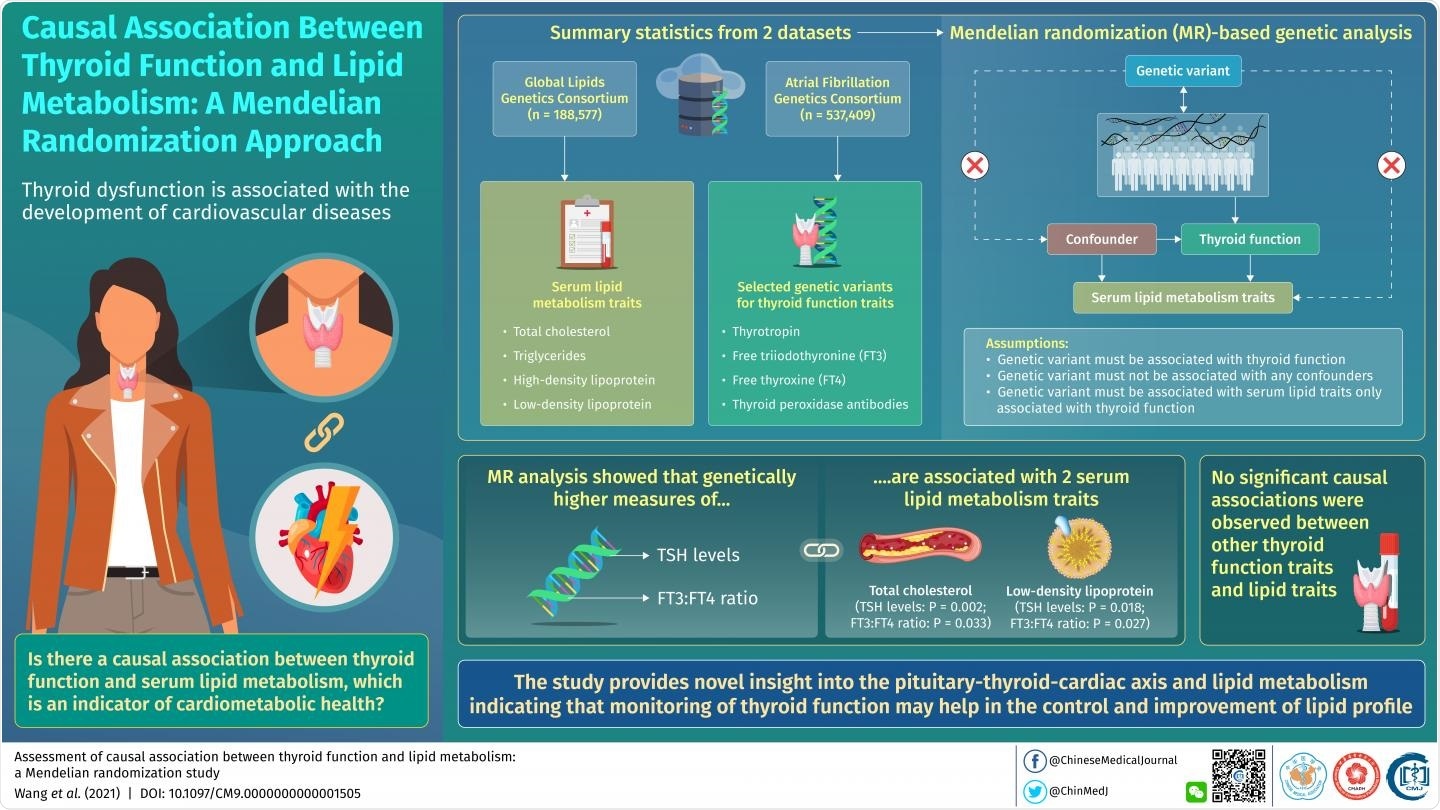The thyroid gland produces amino acid-based compounds known as thyroid hormones. These molecules serve crucial roles in the development and regular functioning of the organism, as they are involved in the direct or indirect regulation of key metabolic pathways.

A recent study published in the Chinese Medical Journal reveals an association between thyroid function and serum lipid profiles with the help of a genetic analysis technique known as “Mendelian randomization.” Image Credit: Chinese Medical Journal.
Thyroid hormones have a complex method for acting on each other and other metabolic processes, but a two-way feedback loop is crucial to their biological function.
Other biochemical processes are affected by dysregulation of the feedback loop that controls their production, resulting in a variety of illnesses, including those connected to the cardiovascular system, liver function, and bone development.
Several clinical investigations have demonstrated the impact of thyroid hormones on lipid levels, such as the fact that treating patients with thyroid hormone analogs improves their lipid levels or that thyroid hormones are linked to glycolipid metabolism and an increased risk of cardiovascular disease (CVD).
These findings point to the possibility of using thyroid hormones to forecast the risk of lipid-related disorders or to build a CVD treatment approach. However, such attempts would require the establishment of a biological cause-and-effect relationship between thyroid hormones and lipid profile, which is yet to be established.
It is worth noting that, despite their intrigue, the results of prior clinical investigations have been unable to pinpoint thyroid hormones as the likely cause of lipid profile changes. Because various confounding factors may have influenced both, the cause-and-effect relationship between thyroid function and lipid profiles may have been muddled.
Furthermore, the observed association between the two could indicate reverse causation, in which the thyroid function was altered by changes in the lipid profile. Thus, a better understanding of the causative dynamics underlying the observed connection between thyroid function and serum lipid profile is required to devise treatment options for lipid-related disorders.
In a recent study published in the Chinese Medical Journal, a group of researchers led by Dr Yi-Da Tang of Peking University’s Department of Cardiology offered a scientific basis for recognizing thyroid function as a causal factor capable of changing serum cholesterol levels.
The researchers used Mendelian randomization (MR) to genetically evaluate epidemiological data. MR is based on the idea that genetic variants in the population are randomly distributed and operate as proxies for environmental exposures that modify biological disease risk in a way that is less likely to be influenced by behavioral, social, or physiological confounding variables.
As we tried to decipher the association between thyroid function and lipid profile, MR offered a solution to mimic a perfectly-designed randomized control trial. The approach allowed us to ward off the confounding factors and the chance of reverse causation and let us observe whether there exists a hidden causal effect of thyroid function on lipid-related disease.”
Dr Yi-Da Tang, Study Corresponding Author, Department of Cardiology, Peking University
The researchers used data from two genome-wide association studies (GWAS) datasets to assess the genotype data of thousands of people.
They used thyrotropin (TSH), free thyroxine (FT4), the ratio of free triiodothyronine (FT3) to free thyroxine (FT3:FT4), and thyroid peroxidase antibodies (TPOAb) as clinical markers of thyroid function.
The researchers next found 115 single-nucleotide polymorphisms in the GWAS that represented genetic variations for thyroid function variables. They used MR analysis to analyze the effect of each of the selected thyroid genetic variations on the selected lipid metabolism variables at the population level.
They discovered that the genetically altered levels of two of the selected thyroid features, TSH level, and FT3:FT4 ratio, were linked to the individuals’ higher TC and LDL levels as potential causation factors for altered lipid levels. However, none of the serum lipid characteristics were linked to the genetically predicted FT4 level or TPOAb concentration.
The findings show a clear link between thyroid function and lipid metabolism in the blood.
Explaining the clinical importance of their findings, “Our study highlights the importance of pituitary-thyroid-cardiac axis in diseases related to dyslipidemia. As we have proved the causal association, patients with thyroid diseases or those on thyroid replacement therapy should pay attention to the thyroid trait and serum lipid profiles to prevent the development of cardiometabolic diseases,” stated Dr. Tang.
Source:
Journal reference:
Jing-Jia, W., et al. (2021) Assessment of causal association between thyroid function and lipid metabolism: a Mendelian randomization study. Chinese Medical Journal. doi.org/10.1097/CM9.0000000000001505.